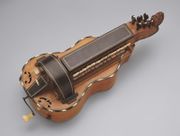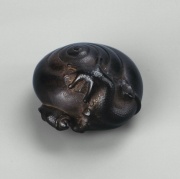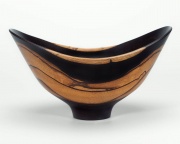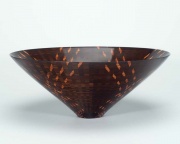Difference between revisions of "Ebony"
(username removed) |
|||
| (4 intermediate revisions by 3 users not shown) | |||
| Line 1: | Line 1: | ||
| − | [[File:11.23618-SC15705.jpg|thumb|]] | + | [[File:Hurdygurdy MFA171735.jpg|thumb|Hurdy-Gurdy<br>MFA# 17.1735]] |
| + | ]][[File:11.23618-SC15705.jpg|thumb|Snail netsuke<br>MFA# 11.2316]] | ||
== Description == | == Description == | ||
Any of trees of the genus ''Diospyros'', with very dark, hard, heavy heartwood. These trees are native to Africa (black or Gaboon ebony, ''D.dendo''), to India and Ceylon (''D.ebenum''), east India (Coromandel or Macassar ebony, ''D.melanoxylon''), Sri Lanka (Calamander ebony, ''D.quaesita''). Ebony's dense, smooth-grain wood has been valued from the earliest times and was imported to Egypt from Nubia and the Sudan (Kuhn 1986). It is extremely durable and resistant to rotting, fungi and powder post beetles. Ebony, even though it is difficult to work and carve, is valued for decorative items, inlay work, black piano keys, musical instruments, and tool handles. It is rarely found in large pieces. | Any of trees of the genus ''Diospyros'', with very dark, hard, heavy heartwood. These trees are native to Africa (black or Gaboon ebony, ''D.dendo''), to India and Ceylon (''D.ebenum''), east India (Coromandel or Macassar ebony, ''D.melanoxylon''), Sri Lanka (Calamander ebony, ''D.quaesita''). Ebony's dense, smooth-grain wood has been valued from the earliest times and was imported to Egypt from Nubia and the Sudan (Kuhn 1986). It is extremely durable and resistant to rotting, fungi and powder post beetles. Ebony, even though it is difficult to work and carve, is valued for decorative items, inlay work, black piano keys, musical instruments, and tool handles. It is rarely found in large pieces. | ||
| − | Several other dark, heavy woods from unrelated species are also called ebony because of their color. These are: green ebony ([ | + | Several other dark, heavy woods from unrelated species are also called ebony because of their color. These are: green ebony ([[cocuswood]]), brown ebony ([[coffeewood]]), blue ebony and Mozambique ebony ([[African blackwood]]). |
| + | |||
| + | [[File:1981.406-SC58777.jpg|thumb|Ebony bowl<br>MFA# 1981.406]] | ||
| − | |||
== Synonyms and Related Terms == | == Synonyms and Related Terms == | ||
black ebony (''Diospyros dendo''); Macassar ebony (''Diospyros melanoxylon''); Calamander ebony (''Diospyros quaesita''); ébène (Fr.); Ebenholz (Deut.); ebano (It.); ébano (Esp., Port.); kokutan (Jap.); (''Diospyros ebenum''); Gaboon ebony; marblewood; partridgewood; acapau; kaki; Coromandel ebony | black ebony (''Diospyros dendo''); Macassar ebony (''Diospyros melanoxylon''); Calamander ebony (''Diospyros quaesita''); ébène (Fr.); Ebenholz (Deut.); ebano (It.); ébano (Esp., Port.); kokutan (Jap.); (''Diospyros ebenum''); Gaboon ebony; marblewood; partridgewood; acapau; kaki; Coromandel ebony | ||
| + | == Personal Risks == | ||
| − | == | + | May cause skin allergies. |
| + | [[File:1990.272-SC58807.jpg|thumb|Macassar ebony<br>MFA# 1990.272]] | ||
| + | == Physical and Chemical Properties == | ||
Rings: obscure. Pores: diffuse, fine. Grain: obscure or invisible. Rays: obscure. | Rings: obscure. Pores: diffuse, fine. Grain: obscure or invisible. Rays: obscure. | ||
| Line 25: | Line 30: | ||
| specific gravity = 1.08 | | specific gravity = 1.08 | ||
|} | |} | ||
| − | |||
| − | |||
| − | |||
| − | |||
| − | |||
| − | |||
| − | |||
| − | |||
| − | |||
== Additional Images == | == Additional Images == | ||
<gallery> | <gallery> | ||
| − | |||
File:qtebonywc.jpg|Macassar ebony ''Diospyros celebica'') | File:qtebonywc.jpg|Macassar ebony ''Diospyros celebica'') | ||
File:Macassar_ebony.jpg|Macassar ebony (Coromendel) (''Diospyros Sp.'') | File:Macassar_ebony.jpg|Macassar ebony (Coromendel) (''Diospyros Sp.'') | ||
</gallery> | </gallery> | ||
| − | + | ==Resources and Citations== | |
| − | == | + | * H.Kuhn, ''Conservation and Restoration of Works of Art and Antiquities'', Butterworths, London, 1986. |
| − | |||
* G.S.Brady, ''Materials Handbook'', McGraw-Hill Book Co., New York, 1971 Comment: p. 285 | * G.S.Brady, ''Materials Handbook'', McGraw-Hill Book Co., New York, 1971 Comment: p. 285 | ||
* Ralph Mayer, ''A Dictionary of Art Terms and Techniques'', Harper and Row Publishers, New York, 1969 (also 1945 printing) | * Ralph Mayer, ''A Dictionary of Art Terms and Techniques'', Harper and Row Publishers, New York, 1969 (also 1945 printing) | ||
| − | |||
| − | |||
* F. H. Titmuss, ''Commercial Timbers of the World'', The Technical Press Ltd., London, 1965 Comment: 70-80 ppcf | * F. H. Titmuss, ''Commercial Timbers of the World'', The Technical Press Ltd., London, 1965 Comment: 70-80 ppcf | ||
| − | * ''Encyclopedia Britannica'', http://www.britannica.com Comment: "Ebony." | + | * ''Encyclopedia Britannica'', http://www.britannica.com Comment: "Ebony." Accessed: 18 Aug. 2004 . |
| − | * | + | * Museum of Japanese Traditional Art Crafts at http://www.nihon-kogeikai.com/ (Jap. term) |
* H.L.Edlin, ''What Wood is That?'', Viking Press, New York, 1969 | * H.L.Edlin, ''What Wood is That?'', Viking Press, New York, 1969 | ||
Latest revision as of 12:50, 2 October 2020
]]
Description
Any of trees of the genus Diospyros, with very dark, hard, heavy heartwood. These trees are native to Africa (black or Gaboon ebony, D.dendo), to India and Ceylon (D.ebenum), east India (Coromandel or Macassar ebony, D.melanoxylon), Sri Lanka (Calamander ebony, D.quaesita). Ebony's dense, smooth-grain wood has been valued from the earliest times and was imported to Egypt from Nubia and the Sudan (Kuhn 1986). It is extremely durable and resistant to rotting, fungi and powder post beetles. Ebony, even though it is difficult to work and carve, is valued for decorative items, inlay work, black piano keys, musical instruments, and tool handles. It is rarely found in large pieces.
Several other dark, heavy woods from unrelated species are also called ebony because of their color. These are: green ebony (Cocuswood), brown ebony (Coffeewood), blue ebony and Mozambique ebony (African blackwood).
Synonyms and Related Terms
black ebony (Diospyros dendo); Macassar ebony (Diospyros melanoxylon); Calamander ebony (Diospyros quaesita); ébène (Fr.); Ebenholz (Deut.); ebano (It.); ébano (Esp., Port.); kokutan (Jap.); (Diospyros ebenum); Gaboon ebony; marblewood; partridgewood; acapau; kaki; Coromandel ebony
Personal Risks
May cause skin allergies.
Physical and Chemical Properties
Rings: obscure. Pores: diffuse, fine. Grain: obscure or invisible. Rays: obscure.
Extremely hard and heavy.
| Density | 69-83 ppcf |
|---|---|
| Molecular Weight | specific gravity = 1.08 |
Additional Images
Resources and Citations
- H.Kuhn, Conservation and Restoration of Works of Art and Antiquities, Butterworths, London, 1986.
- G.S.Brady, Materials Handbook, McGraw-Hill Book Co., New York, 1971 Comment: p. 285
- Ralph Mayer, A Dictionary of Art Terms and Techniques, Harper and Row Publishers, New York, 1969 (also 1945 printing)
- F. H. Titmuss, Commercial Timbers of the World, The Technical Press Ltd., London, 1965 Comment: 70-80 ppcf
- Encyclopedia Britannica, http://www.britannica.com Comment: "Ebony." Accessed: 18 Aug. 2004 .
- Museum of Japanese Traditional Art Crafts at http://www.nihon-kogeikai.com/ (Jap. term)
- H.L.Edlin, What Wood is That?, Viking Press, New York, 1969
- CRC Handbook of Chemistry and Physics, Robert Weast (ed.), CRC Press, Boca Raton, Florida, v. 61, 1980 Comment: density=69-83 ppcf (1.11-1.33 g/cm3)
- Michael McCann, Artist Beware, Watson-Guptill Publications, New York City, 1979





